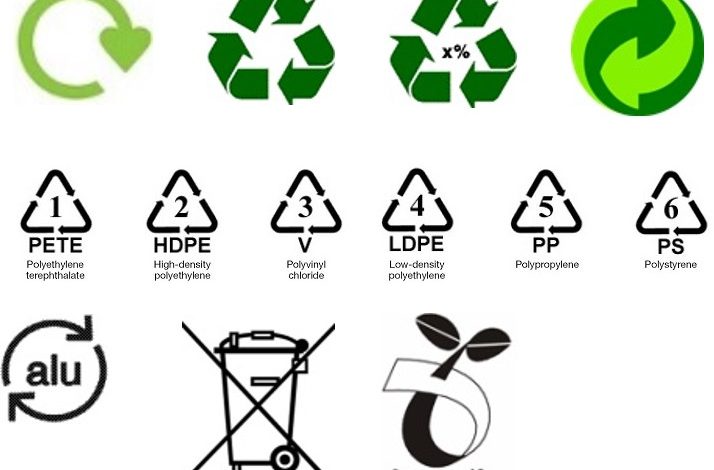What do those symbols on plastic bottles mean? And why are they different from the ones on the box your latest online purchase came in? Here, the cheat sheet you need properly dispose of recyclables.
By ALLISON INGRAM
When did lending a hand to Mother Earth become Hieroglyphics 101? We’ll admit—the chasing arrows and reuse codes befuddle us at times, too. According to the Sustainable Packaging Coalition’s 2015-2016 Report, 94 percent of the US population has access to some type of recycling program, but not every community accepts all materials, thus relying on symbols to dictate reuse and disposal. While the forms might resemble, they can vary in function for consumers and producers alike.
The Federal Trade Commission (FTC) has outlined marketing guidelines for recycled merchandising and promotion, requiring prominent notation of product, package, and service claims. In other words, “recycled content” can refer to the product (say, aluminum foil) or the packaging (cardboard box). And just because your water bottle is recycled, doesn’t mean your cap is too. Here are a few everyday emblems handy for those moments of curbside confusion or grocery-aisle deciphering.
1
Recyclable Symbol
Recyclable Symbol
Recycling’s universal insignia, the Mobius Loop, was coined by University of Southern California student Gary Anderson in honor of the first Earth Day in 1970. Today, the Federal Trade Commission (FTC) recognizes it as an indication of recyclability, meaning it is accepted by most community programs for repurposing, but it doesn’t necessarily contain reclaimed materials.
2
Recycled Symbol
Recycled Symbol
Three arrows enclosed in a circle implies the object is recycled, but take care to note what is repurposed—the packaging, lid or cap, or product itself—as producers are required by the FTC to indicate. Black arrows against a white background imply a combination of new and reused materials, and sometimes contain the exact percentage in the loop’s center. When the arrows are white and the background is black, the product is 100 percent recycled.
3
Plastic Codes
Plastic Codes
Often, plastic items identify the exact type by a ranked Resin Identification Code scale, which indicates the specific category and proper disposal method. For example, polyethylene terephalates (Level 1) compose most clear containers—think soda bottles and ketchup—whereas their screw-on caps are polypropylenes (Level 5). Both can typically be collected curbside, but the former is repurposed for tote bags and the latter becomes brooms or brushes. Not all communities will accept each number, so check with your center before discarding. Hint: The higher the number, the less common the plastic, and thus more difficult to reuse.
4
Industry-Specific Symbols
Glass Recycles Logo
For discarded cardboard, glass, or even mobile phones, organizations like the Electronic Recyclers International or Recycled Paperboard Alliance have adopted their own trademarked badges apart from common monograms. You might recognize cereal boxes branded with the “100% Recycled Paperboard” seal, implying their cardboard is entirely recycled. Or maybe you’ve seen companies bearing certificates of ERI registration. While following FTC guidelines, these groups operate closely on the producer level to monitor accreditation requirements beyond the broad scope of non-trademarked symbols.
This article was taken from: https://www.realsimple.com/home-organizing/recycling-symbols
Contact us:
Phone: 619-456-0009
E-mail: [email protected]




 (2 votes, average: 4.00 out of 5)
(2 votes, average: 4.00 out of 5)